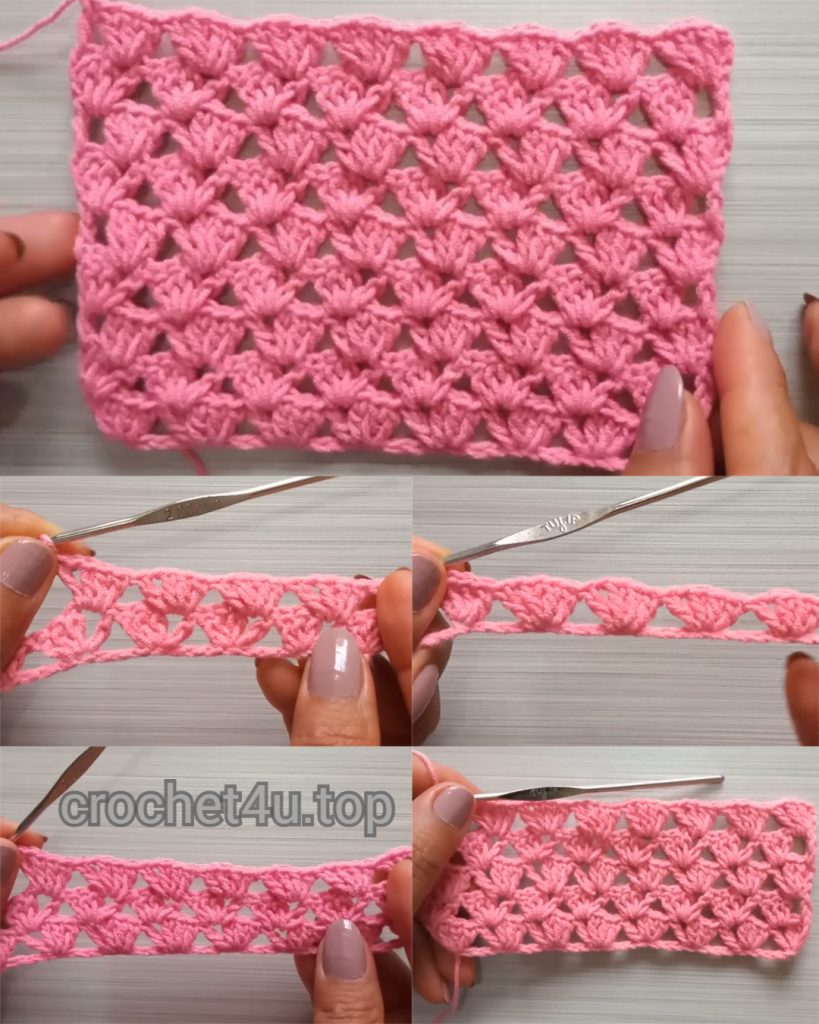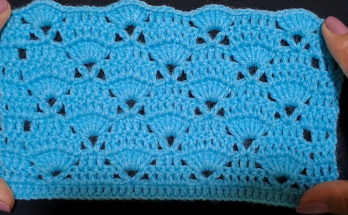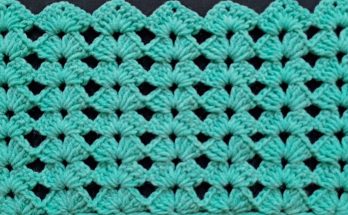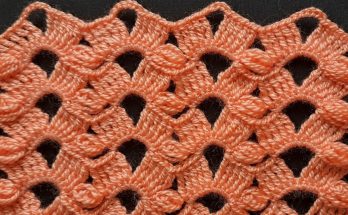
✨ Introduction: The Magic of Simple Repetition
Welcome to a truly elegant and deceptively easy pattern—the Reversible Diamond Shell Lace! This beautiful, repeating motif, demonstrated in the accompanying video tutorial, creates a fabric with a delicate, open texture that is completely reversible. It is the perfect project for both beginners looking to try their first lace stitch and experienced crocheters seeking a quick, satisfying result.
The stitch uses only Double Crochet (DC) and Chain stitches to build a repeating shell structure, creating a diamond-like pattern in the negative space. Its excellent drape and lightweight construction make it ideal for garments and airy home décor.

Why You’ll Love This Stitch
- 100% Reversible: Looks beautiful on both the front and back, making it perfect for scarves and throws.
- Excellent Drape: Ideal for lightweight yarns, resulting in a flowy, sophisticated fabric.
- Easy to Memorize: After the initial setup, the pattern becomes a simple, one-row repeat.
- Versatile: Can be adapted for almost any project where a breathable, textured fabric is desired.
Suggested Projects
| Project Type | Ideal Yarn Weight | Notes |
| Elegant Scarves & Shawls | Fingering (1) or Sport (2) | Highlights the drape and reversible nature. |
| Summer Blouses & Vests | Cotton or Linen Blend | The open lace offers breathability. |
| Table Runner | Worsted Weight Cotton | Provides a neat, textured piece for home décor. |
| Lightweight Baby Blanket | DK (3) or Light Worsted | A fast and airy option for summer babies. |
📌 Pattern Notes & Gauge
This pattern requires careful attention to the starting and ending stitches of the rows to ensure the edges remain straight, while the interior is worked with a simple shell repeat.
Stitch Multiple
The core motif repeat utilizes 4 stitches from the previous row.
Chain a multiple of 4 for your starting foundation.
(The video sample uses 32 chains, which is $4 \times 8$ repeats.)
Gauge (Approximate)
Using a Sport Weight yarn and a 2.0 mm hook (as recommended in the video):
Approximately 1 pattern repeat (one shell and chain space) should measure 0.8 inches in width, and 4 rows should measure 1.5 inches in height.
Always swatch! To ensure the desired drape, you may want to use a hook size larger than your yarn label suggests.
Abbreviations (US Terms)
| Abbreviation | Meaning |
| ch | Chain |
| st(s) | Stitch(es) |
| sl st | Slip Stitch |
| dc | Double Crochet |
| sk | Skip |
| ch-sp | Chain Space |
| Rep | Repeat |
| Shell V-Stitch | The main motif: (3 DC, Ch 1, 1 DC) |
Materials
- Yarn: A smooth yarn, such as a cotton blend (as used in the video) or a fine acrylic, in a Light Fingering, Sport, or DK weight.
- Hook: A size appropriate for your yarn, such as 2.0 mm (B/1) for finer yarns, or a 3.5 mm (E/4) for DK weight.
- Tools: Scissors and a tapestry needle for weaving in ends.

🏗️ The Foundation & Initial Setup (Row 1)
This row establishes the pattern sequence across the starting chain.
- Chain: Ch a multiple of 4 to your desired width. (e.g., Ch 32).
- Row 1 (Foundation Motif):
- Ch 3 (This counts as the first DC).
- Skip 3 ch from the hook.
- Work a Shell V-Stitch (3 DC, Ch 1, 1 DC) into the 4th ch from the hook. (All 4 stitches are worked into this single chain stitch).
- Repeat: [Sk 3 ch. Work a Shell V-Stitch (3 DC, Ch 1, 1 DC) into the 4th ch.] Rep from * across the row until the very last stitch is used.
- End: Your last stitch should be the last motif completed in the final chain stitch.
🐚 The Motif Repeat Rows
The body of the pattern is created by repeating a two-part sequence that consistently places the Shell V-Stitch into the Ch-1 space of the previous row.

Row 2: The Initial Side Edge
This row starts with a slight variation to achieve a straight edge, placing a partial shell into the first Ch-1 space.
- Start: Ch 3 (counts as 1 DC), turn.
- Work 2 DC into the first Ch-1 space of the first motif. (This creates a total of 3 DC, forming the first half of the shell).
- Motif Pattern:
- Ch 1.
- 1 DC into the top of the last DC of the same starting motif (the fourth stitch of the previous motif).
- Shell V-Stitch: Work a Shell V-Stitch (3 DC, Ch 1, 1 DC) into the Ch-1 space of the next motif.
- Repeat Sequence: [Sk the 4 stitches of the next motif. Work a Shell V-Stitch (3 DC, Ch 1, 1 DC) into the Ch-1 space of the following motif.] Rep from * across the row.
- End: Work 1 DC into the final Ch-3 turning chain space of the previous row (or into the top of the 3rd Ch of the turning chain).
Row 3: The Full Shell Start
This row simplifies the start by immediately working a full motif into the first available space, making it the true repeat row for the rest of the project.
- Start: Ch 3 (counts as 1 DC), turn.
- Shell V-Stitch: Work a Shell V-Stitch (3 DC, Ch 1, 1 DC) into the first Ch-1 space of the previous row.
- Motif Pattern:
- Repeat Sequence: [Sk the 4 stitches of the next motif. Work a Shell V-Stitch (3 DC, Ch 1, 1 DC) into the Ch-1 space of the following motif.] Rep from * across the row.
- End: Work 1 DC into the final Ch-3 turning chain space of the previous row (or into the top of the 3rd Ch of the turning chain).
🔄 The Vertical Repeat
To continue this pattern to your desired length, you will simply alternate repeating Row 2 and Row 3.
- Row 4: Repeat Row 2.
- Row 5: Repeat Row 3.
- …and so on.


Key Pattern Checkpoints
- The Shell Placement: The Shell V-Stitch (3 DC, Ch 1, 1 DC) is always worked into the Ch-1 space of the motif below. This creates the continuous chain of lace diamonds.
- The Skips: You will always skip the four stitches that make up the motif from the previous row (3 DC and 1 DC).
- The Edges:
- Rows beginning with a partial shell (like Row 2) ensure the edge remains flat and prevents bowing.
- Rows beginning with a full shell (like Row 3) ensure the pattern begins and ends on the same stitch configuration for a cleaner look.
✂️ Finishing & Project Ideas
Finishing

Once your project has reached the desired length:
- Fasten off, leaving a long tail for weaving.
- Use a tapestry needle to weave the remaining yarn tails securely into the side edges. Since the fabric is reversible, be meticulous about hiding the tails within the double crochet posts on the edges.
- Blocking: This stitch benefits immensely from blocking. Pin the fabric out, wet it thoroughly (or steam it, depending on your yarn), and let it dry completely. Blocking will open up the lace holes and improve the drape significantly.
Border Suggestions
Since the shell work naturally creates a scalloped edge on the top and bottom, only the sides usually require attention.
- Simple Edge: Work a single round of Single Crochet (SC) evenly along the two long side edges for a neat, subtle finish.
- Picot Edge: For a slightly fancier finish, work (SC, Ch 3, SC) in alternating side stitches along the edge.
Enjoy the beautiful simplicity and effortless elegance of your new Diamond Shell Lace fabric!



